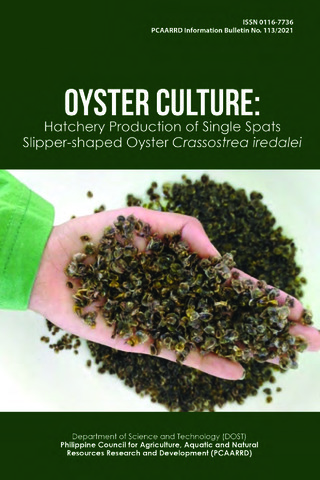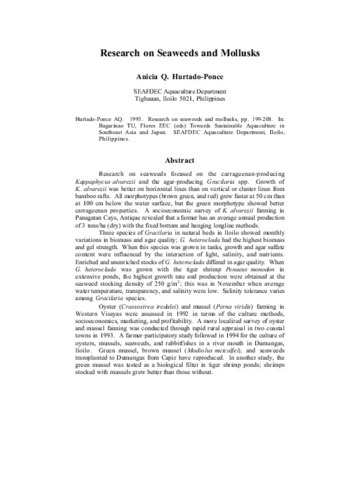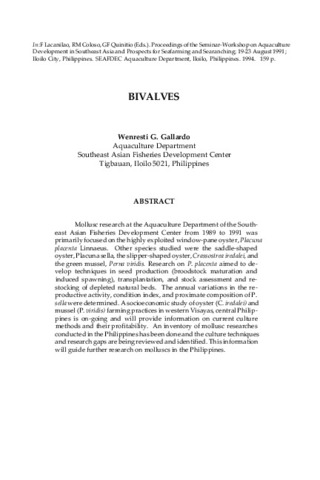Perlihatkan publikasi sederhana
Transplantation, hatchery, and grow-out of window-pane oyster Placuna placenta in Guimaras and Iloilo
| dc.contributor.author | Garibay, Soledad S. | |
| dc.contributor.author | Golez, Salvacion N. | |
| dc.contributor.author | Unggui, Abdul S. | |
| dc.contributor.editor | Bagarinao, Teodora | |
| dc.date.accessioned | 2018-03-15T09:30:04Z | |
| dc.date.available | 2018-03-15T09:30:04Z | |
| dc.date.issued | 2007 | |
| dc.identifier.citation | Garibay, S. S., Golez, S. N., & Unggui, A. S. (2007). Transplantation, hatchery, and grow-out of window-pane oyster Placuna placenta in Guimaras and Iloilo. In T. U. Bagarinao (Ed.), Research Output of the Fisheries Sector Program (Vol. 2. Reports on Fisheries and Aquaculture, pp. 119-122). Quezon City, Philippines: Bureau of Agricultural Research, Department of Agriculture. | en |
| dc.identifier.isbn | 9718511776 | |
| dc.identifier.uri | http://hdl.handle.net/10862/3279 | |
| dc.description.abstract | The windowpane oyster Placuna placenta (local name kapis) used to be harvested in large quantities and support a shellcraft industry in the Philippines, particularly in Panay Island. But the fishery and the industry declined markedly by the 1990s. Studies were conducted to transplant kapis and also to develop hatchery techniques for it in an effort to counter the population depletion. Kapis with average shell heights of 7 cm and 10 cm were transplanted from Roxas City in northern Panay Island and from Oton, Iloilo in southern Panay to Taklong Island in Guimaras during the rainy season (July–November) and the dry season (February–June). Survival of the transplants was higher during the dry season (57–60%) than during the rains (35–48%). Sexually mature kapis 10 cm in shell height were induced to spawn by temperature manipulation, water level manipulation, and use of ultravioletirradiated sea water. Spawning was successfully induced by raising the water temperature to 29±0.5oC. Eggs measured 45 μm on average, and fecundity was 5,000–10,000 per female. Kapis larvae were reared on a combination of the microalgae Isochrysis galbana, Tetraselmis sp., and Chaetoceros calcitrans, maintained at a density of 100,000 cells/ml. Three water treatment schemes were tested for larval rearing: chlorination, ultraviolet irradiation, and filtration (control). Larvae survived to the umbo veliger stage (180 μm, day 10) in chlorinated sea water whereas mass mortality occurred at the straight-hinge stage (days 4–) in both UV-treated and filtered sea water. | en |
| dc.language.iso | en | en |
| dc.publisher | Bureau of Agricultural Research, Department of Agriculture | en |
| dc.subject | Placuna placenta | en |
| dc.subject | Philippines | en |
| dc.title | Transplantation, hatchery, and grow-out of window-pane oyster Placuna placenta in Guimaras and Iloilo | en |
| dc.type | Book chapter | en |
| dc.citation.spage | 119 | |
| dc.citation.epage | 122 | |
| dc.citation.bookTitle | Research Output of the Fisheries Sector Program | en |
| dc.subject.asfa | oysters | en |
| dc.subject.asfa | oyster culture | en |
| dc.subject.asfa | transplantation | en |
| dc.subject.asfa | hatcheries | en |
| dc.subject.asfa | stocking (organisms) | en |
| dc.subject.asfa | fishery management | en |
| dc.subject.asfa | stocks | en |
| dc.subject.asfa | induced ovulation | en |
| dc.subject.asfa | molluscan larvae | en |
| dc.subject.asfa | marine molluscs | en |
| dc.subject.asfa | breeding stock | en |
| dc.subject.asfa | survival | en |
| dc.subject.asfa | mortality | en |
Files in this item
| Files | Size | Format | View |
|---|---|---|---|
|
There are no files associated with this item. |
|||



